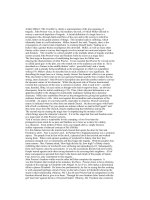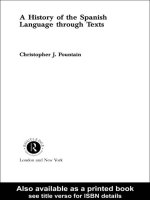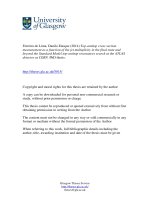A characterization of the class EχlocΩ
Bạn đang xem bản rút gọn của tài liệu. Xem và tải ngay bản đầy đủ của tài liệu tại đây (266.49 KB, 6 trang )
A characterization of the class Eχ,loc(Ω)
Vu Viet Hung
Department of Mathematics, Physics and Informatics,
Tay Bac University, Son La, Viet Nam
E-mail:
Abstract
The main aim of the present paper is to study the class Eχ,loc (Ω) and
some of its consequences.
1
Introduction
Let Ω be a hyperconvex domain in Cn . By P SH(Ω) (resp. P SH − (Ω)) we
denote the set of plurisubharmonic functions (resp. negative plurisubharmonic
functions) on Ω. In [Ce2], Cegrell introduced a general class E(Ω) of psh functions
on which the complex Monge-Amp`ere operator (ddc .)n is well defined. Moreover,
in [Ce2], he has proved the class E(Ω) is the biggest class on which the complex
Monge-Amp`ere operator (ddc .)n is well defined as a Radon measure and it is
continuous under decreasing sequences. This class was explicitly characterized in
papers [Bl1], [Bl2].
On the other hand, an another weighted energy class Eχ (Ω) which extends the
classes Ep (Ω) and F(Ω) in [Ce1] and [Ce2] introduced and investigated recently
by Benelkourchi, Guedj and Zeriahi in [BGZ] is as follows. Let χ : R− −→ R+ be
a decreasing function. Following [BGZ], we introduce the weighted energy class
of plurisubharmonic functions
Eχ (Ω) = {ϕ ∈ P SH − (Ω) : ∃ E0 (Ω)
ϕj
χ(ϕj )(ddc ϕj )n < +∞},
ϕ, sup
j≥1
Ω
where E0 (Ω) is the cone of bounded plurisubharmonic functions ϕ defined on Ω
with finite total Monge-Amp`ere mass and lim ϕ(z) = 0 for all ξ ∈ ∂Ω. In [HH],
z→ξ
2010 Mathematics Subject Classification: 32U05, 32U15, 32U40, 32W20.
Key words and phrases: plurisubharmonic functions, weighted energy classes, complex
Monge-Amp`ere operator
1
2
V. V. Hung
Hai and Hiep proved that Eχ (Ω) ⊂ E(Ω). We note that, when χ(t) = (−t)p , Eχ (Ω)
is the class Ep (Ω) studied by Cegrell in [Ce1].
Next, from [HHQ], we introduce the following class Eχ,loc (Ω). First, let H(Ω) ⊂
P SH − (Ω), we say that ϕ ∈ P SH − (Ω) belongs to Hloc (Ω) if for every hyperconvex
domain D
Ω there exists ψ ∈ H(Ω) such that ψ = ϕ on D. In the case
H(Ω) = Eχ (Ω) we obtain the class Eχ,loc (Ω). It is well known that in [HHQ], the
authors proved that if χ(2t) ≤ aχ(t) for some a > 1 and χ ∈ K then Eχ,loc is a
local class.
In this paper, we give a characterization of the class Eχ,loc (Ω), which is a generalization of Theorem 1.1 in [Bl2]. Namely, we have following result.
Theorem 3.2. Let Ω ⊂ Cn−1 , Ω ⊂ C are bounded hyperconvex domains and u :
Ω → [−∞, +∞) is a function in P SH − (Ω ) and χ ∈ K. Then u ∈ Eχ(t),loc (Ω ×
Ω ) if and only if u ∈ Eχ(t)|t|,loc (Ω ).
Next, we shall then use this result to give some consequences in section 4.
The paper is organized as follows. Beside the introduction the paper has three
sections. We also recall the Cegrell classes of plurisubharmonic functions F(Ω)
and E(Ω) in section 2. In section 3, we prove a characterization of the class
Eχ,loc (Ω) under some extra assumptions on weights χ. Finally, by relying on this
characterization, we give some consequences.
2
Preliminairies
Some elements of pluripotential theory that will be used throughout the paper
can be found in [ACCH], [ACH], [Be], [BT1], [BT2], [Ce1], [Ce2], [Kl], [Ko1],
[Ko2]. Now we recall the definition of some Cegrell classes of plurisubharmonic
functions (see [Ce1] and [Ce2]). Let Ω be an open subset in Cn . By β = ddc z
2
we denote the canonical K¨
ahler form of Cn where d = ∂ + ∂ and dc = i(∂ − ∂),
hence, ddc = 2i∂∂.
As in [Ce1] and [Ce2] we define the classes E0 (Ω), F(Ω) and E(Ω) as follows. Let
Ω be a bounded hyperconvex domain in Cn . This means that Ω is a connected,
bounded open subset and there exists a negative plurisubharmonic function
such that for all c < 0 the set Ωc = {z ∈ Ω : (z) < c}
Ω. Set
E0 = E0 (Ω) = {ϕ ∈ P SH − (Ω) ∩ L∞ (Ω) : lim ϕ(z) = 0, ∀ξ ∈ ∂Ω,
(ddc ϕ)n < ∞}
z→ξ
Ω
F = F(Ω) = ϕ ∈ P SH − (Ω) : ∃ E0 (Ω)
ϕj
(ddc ϕj )n < ∞ ,
ϕ, sup
j
Ω
A characterization of the class Eχ,loc (Ω)
3
and
E = E(Ω) = ϕ ∈ P SH − (Ω) :∀z0 ∈ Ω, ∃ a neighbourhood D
E0 (Ω)
ϕj
z0 ,
(ddc ϕj )n < ∞ .
ϕ on D, sup
j
Ω
To simplify the notation we will write ”A
B” if there exists a constant C > 0
such that A ≤ CB. The following class of functions were introduced in [HHQ]
K = {χ : R− −→ R+ is a decreasing function such that
− t2 χ (t)
tχ (t)
χ(t), ∀t < 0}.
Remark 2.1. (i) If χ(t) = (−t)p then χ ∈ K.
(ii) If χ ∈ K then χ(2t) ≤ aχ(t), ∀t < 0 with some a > 1. Indeed, by hypothesis
tχ (t) ≤ Cχ(t), C = constant > 0 we set s(t) =
χ(t)
.
(−t)C
Then s (t) ≥ 0, ∀t < 0,
hence s(t) is an increasing function. This implies that s(2t) ≤ s(t) and we have
χ(2t) ≤ 2C χ(t).
Some notes in the class Ep,loc
3
We set z = (z1 , . . . , zn−1 , zn ) = (z , zn ) ∈ Cn . First, we have the main result
Theorem 3.1. Let Ω ⊂ Cn−1 , Ω ⊂ C are bounded hyperconvex domains and u :
Ω → [−∞, +∞) is a function in P SH − (Ω ) and χ ∈ K. Then u ∈ Eχ(t),loc (Ω ×
Ω ) if and only if u ∈ Eχ(t)|t|,loc (Ω ).
Proof. We set uj = max(u, −j). Then we have {uj } ⊂ P SH − ∩ L∞ (Ω ), uj
u
on Ω . We have
(ddc uj )n = 0 on Ω × Ω
and
(ddc uj )n−p ∧ (ddc z 2 )p = (ddc uj )n−p ∧ (ddc z
for all 1 ≤ p ≤ n. Next, we take ∀K
Ω , ∀K
2 p−1
)
⊗ dV2 (zn ),
Ω . From (1) we have
χ(uj )|uj |p (ddc uj )n−p ∧ (ddc z 2 )p
K ×K
χ(uj )|uj |p (ddc uj )n−p ∧ (ddc z
=
2 p−1
)
⊗ dV2 (zn )
K ×K
χ(uj )|uj |p (ddc uj )n−p ∧ (ddc z
=
K
2 p−1
)
K
dV2 (zn ),
(1)
4
V. V. Hung
for all 1 ≤ p ≤ n. Hence
χ(uj )|uj |p (ddc uj )n−p ∧ (ddc z 2 )p < +∞
sup
j≥1
K ×K
⇔ sup
χ(uj )|uj |p (ddc uj )n−p ∧ (ddc z
2 p−1
)
< +∞
j≥1
K
⇔ sup
χ(uj )|uj ||uj |p−1 (ddc uj )(n−1)−(p−1) ∧ (ddc z
2 p−1
)
< +∞
j≥1
K
for all 1 ≤ p ≤ n.
Finally, we infer that u ∈ Eχ(t),loc (Ω × Ω ) if and only if u ∈ Eχ(t)|t|,loc (Ω ) as
desired.
Corollary 3.2. Let Ω ⊂ Cn−1 , Ω ⊂ C are bounded hyperconvex domains and
u ∈ P SH − (Ω ). Then u ∈ Ep,loc (Ω × Ω ) if and only if u ∈ Ep+1,loc (Ω ).
Proof. Using Theorem 3.1 for χ(t) = (−t)p , ∀t < 0 and we get the desired conclusion.
Remark 3.3. As Example 2.3 in [Ce1], for each 0 < α < 1 we consider functions
uα (z ) = −(− log z )α + (log 2)α ,
on Ω = B(0, 21 ) = {z ∈ Cn−1 : z
if p <
n
α
< 12 }. By [Ce1], we have uα ∈ Ep (Ω ) if only
− n. By Proposition 2.3 in [CKZ], we have uα ∈ E(Ω × ∆), ∀0 < α < n1 .
Since (ddc uα )n = 0 on Ω = Ω × ∆, we have
χ(uα )(ddc uα )n = 0.
Ω
However, we will show that uα ∈ Ep,loc (Ω) for p =
that uα ∈ Ep,loc (Ω) for p =
n
α
n
α
− n − 1. Indeed, we assume
− n − 1. By Corollary 4.2, we get uα ∈ Ep+1,loc (Ω ).
Moreover, since lim uα (z ) = 0, ∀ξ ∈ ∂Ω we obtain uα ∈ Ep+1 (Ω ). This is a
z →ξ
contradiction.
Acknowledgement
The author would like to thank Professor Pham Hoang Hiep for valuable comments during the preparation of this work. The paper was done while the author
were visiting Vietnam Institute for Advanced Study in Mathematics (VIASM).
The author would like to thank the VIASM for hospitality and support.
References
[ACCH] P. Ahag, U. Cegrell, R. Czyz and Pham Hoang Hiep, Monge-Amp`ere
measures on pluripolar sets, J. Math. Pures Appl., 92 (2009), 613-627.
A characterization of the class Eχ,loc (Ω)
5
[ACH] P. Ahag, R. Czyz and Pham Hoang Hiep, Concerning the energy class Ep
for 0 < p < 1, Ann. Polon. Math., 91 (2007), 119-130.
[BT1] E. Bedford and B. A. Taylor, A new capacity for plurisubharmonic functions, Acta Math., 149 (1982), 1–40.
˘
[BT2] E. Bedford and B. A. Taylor, Fine topology, Silov
boundary, and (ddc )n ,
J. Funct. Anal., 72 (1987), 225–251.
[Be]
S. Benelkourchi, Weighted Pluricomplex Energy, Potential Analysis, 31
(2009), 1–20.
[BGZ] S. Benelkourchi, V. Guedj and A. Zeriahi, Plurisubharmonic functions
with weak singularities, Complex Analysis and Digital Geometry Proceedings from the Kiselmanfest, Uppsala Universitet, Uppsala, 2007 ISSN 05027454, 57–73.
[Bl1]
Z. Blocki, On the definition of the Monge-Amp`ere operator in C2 , Math.
Ann., 328 (2004), 415–423.
[Bl2]
Z. Blocki, The domain of definition of the complex Monge-Amp`ere operator, Amer. J. Math., 128 (2006), 519–530.
[Ce1] U. Cegrell, Pluricomplex energy, Acta Mathematica, 180 (1998), 187–217.
[Ce2] U. Cegrell, The general definition of the complex Monge-Amp`ere operator,
Ann. Inst. Fourier, 54 (2004), 159–179.
[CKZ] U. Cegrell, S. Kolodziej and A. Zeriahi, Subextension of plurisubharmonic
functions with weak singularities, Math. Z., 250 (2005), 7–22.
[HH]
Le Mau Hai and Pham Hoang Hiep, Some Weighted Energy Classes of
Plurisubharmonic Functions, Potential Analysis, 34 (2011), 43–56.
[HHQ] Le Mau Hai, Pham Hoang Hiep and Hoang Nhat Quy, Local property of
the class Eχ,loc , J. Math. Anal. Appl., 402 (2013), 440–445.
[Kl]
M. Klimek, Pluripotential Theory, The Clarendon Press Oxford University
Press, New York, 1991, Oxford Science Publications.
[Ko1] S. Kolodziej, The range of the complex Monge-Amp`ere operator II, Indiana
Univ. Math. J., 44 (1995), 765–782.
6
V. V. Hung
[Ko2] S. Kolodziej, The complex Monge-Amp`ere equation and pluripotential theory, Mem. Amer. Math. Soc., 178 (2005), 64p.









